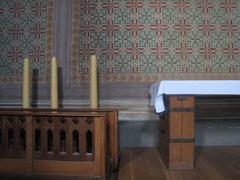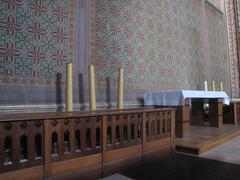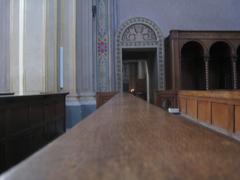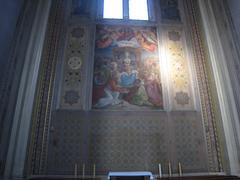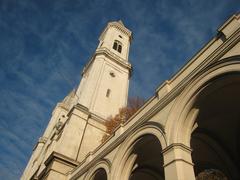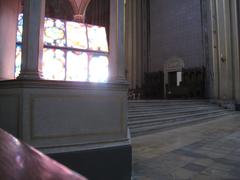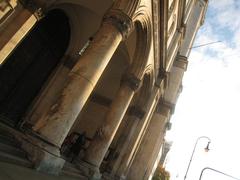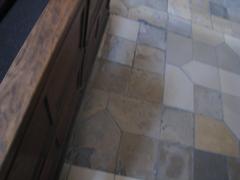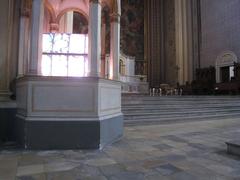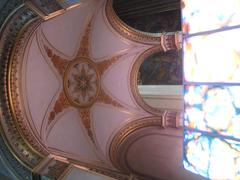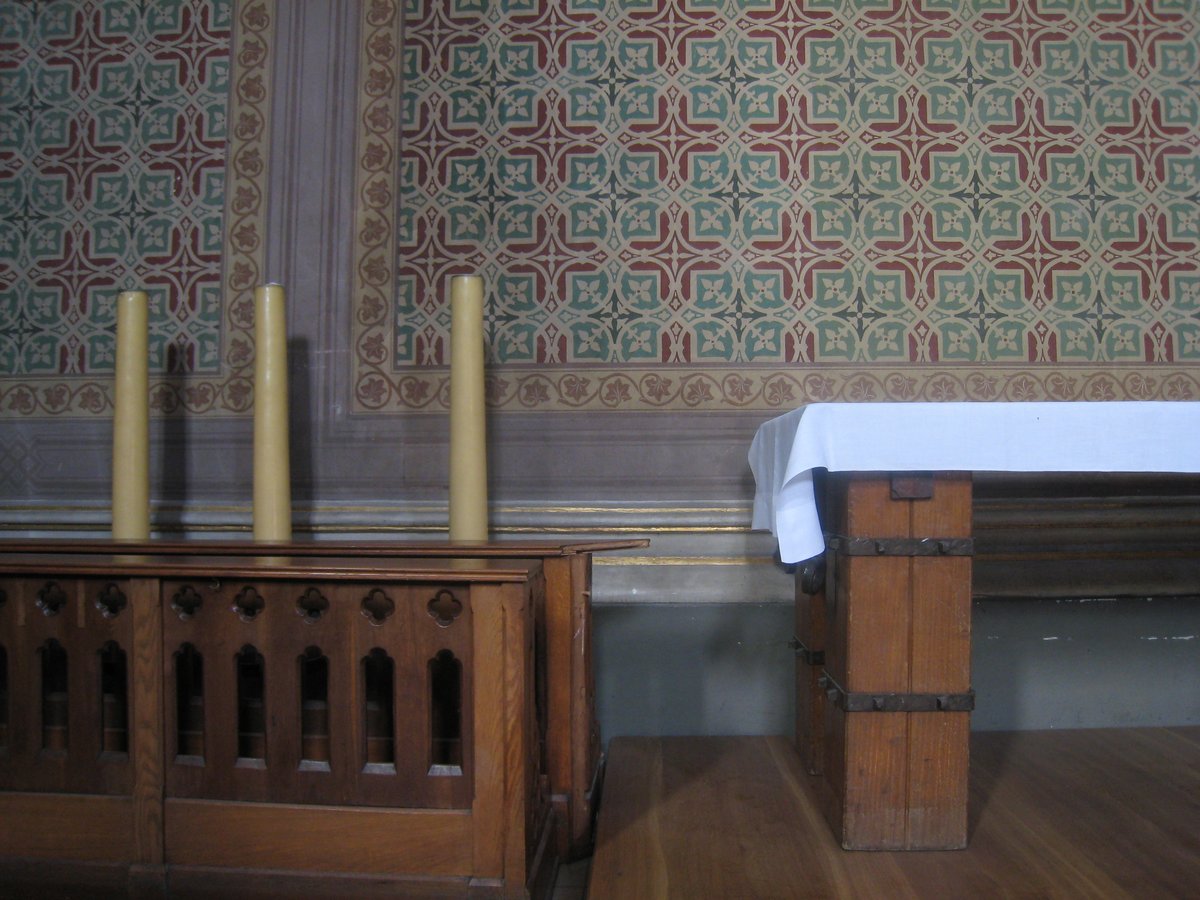
Ludwigskirche Munich: Visiting Hours, Tickets, and Historical Sites Guide
Date: 15/06/2025
Introduction
Nestled on Ludwigstraße in Munich’s vibrant Maxvorstadt, Ludwigskirche—formally the Catholic Parish and University Church of St. Ludwig—is a crown jewel of 19th-century neo-Romanesque architecture and Bavarian heritage. Commissioned by King Ludwig I of Bavaria and designed by Friedrich von Gärtner between 1829 and 1844, the church is a hallmark of the Rundbogenstil (“round-arch style”). Ludwigskirche is more than a place of worship; it is an artistic, academic, and urban landmark, serving as the university church for Ludwig Maximilian University (LMU) and as a hub for cultural events. Its monumental twin towers, colossal altar fresco by Peter von Cornelius, and dynamic interplay of tradition and modernity make it a must-visit destination in Munich.
This comprehensive guide covers Ludwigskirche’s historical foundations, architectural and artistic highlights, visiting hours, ticket policies, accessibility, travel tips, and much more. Whether you’re an art lover, history enthusiast, spiritual seeker, or traveler, Ludwigskirche offers an enriching experience at the heart of Munich’s cultural scene. For official information, consult resources like Munich Travel, Destination Munich, and toeightycountries.com.
Table of Contents
- Historical Foundations and Royal Patronage
- Neo-Romanesque Design and Rundbogenstil Influence
- Floor Plan and Spatial Organization
- Monumental Altar Fresco: Peter von Cornelius’ “The Last Judgment”
- Additional Artistic Features
- Acoustic and Musical Significance
- Urban and Cultural Impact
- Ludwigskirche’s Role in Maxvorstadt and Community Life
- Visiting Ludwigskirche: Practical Information
- Visitor Experience and Facilities
- Special Considerations
- Frequently Asked Questions (FAQ)
- Conclusion and Plan Your Visit
- References
Historical Foundations and Royal Patronage
The Vision of King Ludwig I
King Ludwig I ascended the Bavarian throne in 1825, inspired by classical ideals and intent on transforming Munich into a European cultural capital. His vision extended far beyond religious devotion; Ludwigskirche, alongside projects like the Alte Pinakothek and the Propylaea, was meant to create an “Athens on the Isar,” where faith, art, and scholarship flourished side by side (toeightycountries.com).
Foundation and Construction
The church’s foundation stone was laid on August 25, 1829—Ludwig’s name day—symbolizing the king’s personal investment in the project. Ludwigskirche’s location on the grand Ludwigstraße, Munich’s key north-south axis, highlights the church’s dual role as both a spiritual and academic landmark. Despite financial obstacles, the king’s determination ensured its completion in 1844 (toeightycountries.com).
Architectural Patronage: Friedrich von Gärtner
Ludwigskirche was designed by Friedrich von Gärtner, a trusted royal architect, in the innovative neo-Romanesque Rundbogenstil. This style, characterized by rounded arches and monumental solidity, was inspired by Italian Romanesque architecture and went on to influence countless buildings throughout Germany and abroad (storiesbysoumya.com).
The University Connection
As the university church for LMU, Ludwigskirche underscores the union of faith and learning. Its proximity to LMU’s main building, also designed by Gärtner, is a testament to the king’s vision of integrating spiritual and intellectual life (toeightycountries.com).
Artistic Patronage: Peter von Cornelius and the Nazarene Movement
King Ludwig I commissioned Peter von Cornelius, a leader of the Nazarene movement, to create the monumental fresco “The Last Judgment” (1836–1840), the second-largest altar fresco worldwide (storiesbysoumya.com). The Nazarene movement aimed to revive early Renaissance spirituality and aesthetics, and its influence is evident throughout Ludwigskirche.
Socio-Political Impact and Legacy
Ludwigskirche and other Ludwig I projects provided employment, fostered civic pride, and established Munich as a center of art and culture. Today, Ludwigskirche remains a vibrant landmark, reflecting the king’s legacy (storiesbysoumya.com).
Neo-Romanesque Design and Rundbogenstil Influence
Ludwigskirche is one of the earliest and most influential examples of the Rundbogenstil, a 19th-century architectural style marked by rounded arches, heavy masonry, and monumental forms. The twin towers, each rising 71 meters, form a striking counterpoint to the Theatinerkirche and anchor the northern terminus of Ludwigstraße (Destination Munich; Munich Travel). This style was widely adopted in both church and civic architecture across Germany and in the United States (SpottingHistory).
Floor Plan and Spatial Organization
The church is built on a three-aisled basilica plan, shaped as a tau (T-shaped) cross—a rare form in Western Europe (Wikipedia). The airy nave, flanked by side aisles and marked by massive columns and rounded arches, leads to a prominent transept and an eastern apse. This spatial organization not only supports the monumental architecture but also enhances the acoustic and visual experience.
Monumental Altar Fresco: Peter von Cornelius’ “The Last Judgment”
The altar fresco “The Last Judgment” is one of the world’s largest, covering over 200 square meters (Munich Travel). Commissioned to rival Michelangelo’s Sistine Chapel masterpiece, it depicts Christ enthroned among angels and saints, surrounded by the resurrected dead. Cornelius’ work is celebrated for its clarity, scale, and expressive power, though it reportedly failed to please King Ludwig I, leading to the artist’s departure from Munich (Destination Munich).
Additional Artistic Features
Sculptural Program
Above the main portal are statues of Christ and the four Evangelists, providing a scriptural welcome to visitors (Destination Munich). The restrained, expressive sculptures reinforce the church’s liturgical and educational mission.
Modern Interventions and Mosaic Roof
A contemporary artwork, “Golgotha” by Wilhelm Breitsameter, in the left transept, offers a striking modern contrast within the historic sanctuary. The roof’s 2007–2009 restoration reinstated an original polychromatic mosaic design, adding vibrancy to the Munich skyline (SpottingHistory).
Acoustic and Musical Significance
Ludwigskirche’s acoustics are renowned, making it a favored venue for sacred music and organ concerts. The church houses a significant organ and a set of bells named after King Ludwig I’s family, underscoring its royal connections and musical heritage (Munich Travel).
Urban and Cultural Impact
Ludwigskirche was pivotal in establishing the “Kunstareal” (art district) and shaping Munich’s identity as a cultural metropolis. Its integration into Ludwigstraße’s urban plan created a grand boulevard that remains a focal point for both civic and cultural life (Munich Travel).
Ludwigskirche’s Role in Maxvorstadt and Community Life
Situated at the heart of Maxvorstadt, Ludwigskirche is surrounded by iconic landmarks such as LMU, the Bavarian State Library, the Alte Pinakothek, and Königsplatz. The church is a lively center for community events, university gatherings, and concerts, and serves diverse communities, including the Syriac Maronite Church (Miss Tourist).
Maxvorstadt’s artistic and academic heritage is closely linked to Ludwigskirche, which acts as a connector between the city’s cultural institutions and its vibrant student life. The area is well-served by public transport and is a popular walking and biking route, with many cafés and bookstores nearby.
Visiting Ludwigskirche: Practical Information
Location and Getting There
- Address: Ludwigstraße 20, Maxvorstadt, Munich
- Public Transport: U-Bahn “Universität” (U3, U6), tram lines 18 or 27 (Ludwigstraße stop)
- Parking: Limited street parking; use nearby garages such as Parkhaus am Salvatorplatz
Opening Hours
- Monday to Saturday: 9:00 AM – 6:00 PM
- Sunday and Public Holidays: 12:00 PM – 6:00 PM
Hours may vary during religious services or events. Check the official parish website for updates.
Tickets and Admission
- Admission: Free (donations welcome; no tickets required)
Guided Tours
- Available for groups; often included in Maxvorstadt or art district tours. Arrange in advance through the parish office or local tourism agencies.
Accessibility
- Wheelchair accessible with street-level entrances and ramps. Some side chapels or upper areas may have restricted access. Assistance is available upon request.
Photography
- Permitted for personal use without flash or tripods. Please respect ongoing services.
Dress Code and Etiquette
- Modest attire (cover shoulders and knees) is required. Maintain silence during services; mobile phones on silent.
Amenities
- No restrooms inside, but facilities are available nearby.
- Maxvorstadt offers cafés, bakeries, restaurants, and bookstores within walking distance.
Nearby Attractions
- Ludwig-Maximilians-Universität (LMU)
- Alte Pinakothek
- Siegestor
- Englischer Garten
- Königsplatz
Visitor Experience and Facilities
Ludwigskirche’s spacious, luminous interior and serene ambiance offer an ideal setting for reflection and appreciation of monumental art. Early mornings or late afternoons provide optimal light and fewer crowds. Plan to spend about an hour to fully appreciate the architecture, frescoes, and atmosphere.
Special Considerations
- Restoration: Major restorations, including asbestos removal and roof mosaic reinstallation, have preserved the church’s historic character and safety.
- Community Engagement: The parish runs libraries, kindergartens, and social programs, and hosts concerts and community events.
- Language: Most signage is in German, but some English information is available. Many staff and volunteers speak English.
Frequently Asked Questions (FAQ)
Q: What are Ludwigskirche’s visiting hours?
A: Monday to Saturday, 9:00 AM–6:00 PM; Sunday and public holidays, 12:00 PM–6:00 PM. Check for updates during holidays or events.
Q: Is there an admission fee for Ludwigskirche?
A: No, entry is free; donations are appreciated.
Q: Are guided tours available?
A: Yes, by arrangement or as part of larger tours.
Q: Is Ludwigskirche wheelchair accessible?
A: Yes, with street-level access and ramps.
Q: Can I take photographs inside?
A: Yes, but avoid flash and be respectful during services.
Q: What nearby attractions can I combine with my visit?
A: LMU, Alte Pinakothek, Königsplatz, Siegestor, and the Englischer Garten are all within walking distance.
Conclusion and Plan Your Visit
Ludwigskirche is an essential stop for anyone exploring Munich’s history, architecture, and culture. Its monumental design, masterful frescoes, and central role in Maxvorstadt’s academic and artistic life ensure a memorable experience for visitors of all interests. Take advantage of free admission, guided tours, and nearby attractions to enrich your visit.
Ready to explore Ludwigskirche? Download the Audiala app for guided audio tours and insider tips. Explore related posts on Munich’s historical sites and follow us on social media for the latest updates and inspiration.
References
- Ludwig I and His Classicist Buildings in Munich, 2023, toeightycountries.com (https://toeightycountries.com/ludwig-i-his-classicist-buildings-in-munich-en)
- Churches in Munich Germany, 2024, StoriesBySoumya (https://www.storiesbysoumya.com/churches-in-munich-germany/)
- Ludwigskirche, Munich, 2024, Wikipedia (https://en.wikipedia.org/wiki/Ludwigskirche,_Munich)
- Ludwigskirche - Destination Munich, 2024, Destination Munich (https://www.destination-munich.com/ludwigskirche.html)
- Ludwigskirche, Munich Travel, 2024, Munich Travel (https://www.munich.travel/en/pois/urban-districts/ludwigskirche)
- Things to Do in Munich Germany, 2024, Miss Tourist (https://misstourist.com/things-to-do-in-munich-germany/)
